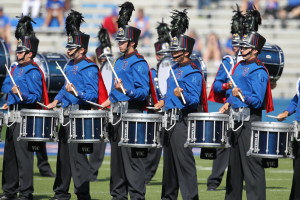What Band Directors Need to Know About Yamaha Drums
Jul 24, 2015
From One Head Drumline Instructor to Another
Brandon Graves, University of Kansas Marching Jayhawks’ head drumline instructor, knows a thing or two about selecting and caring for marching band drums. Not only does he oversee KU’s Marching Jayhawks’ drumline programs and exercises, but he also is in charge of the drumline’s day-to-day operations.
 Recently, Brandon handled the university’s investment in a new drumline, including eleven snare drums, seven bass drums and six multi-tenor drums. The last time KU purchased a new drumline set was in 2007. This is the second consecutive time Yamaha was chosen for the Marching Jayhawks.
Recently, Brandon handled the university’s investment in a new drumline, including eleven snare drums, seven bass drums and six multi-tenor drums. The last time KU purchased a new drumline set was in 2007. This is the second consecutive time Yamaha was chosen for the Marching Jayhawks.
Why Yamaha?
“Being a Yamaha-sponsored clinician since 2009, I represent the company as a performer and an educator. I teach drum clinics and master classes on Yamaha drums,” says Brandon. “I play Yamaha drums. They would be my preference whether I was a sponsored clinician or not. Yamaha drums, in my opinion, are of the highest quality and cover all the needs of a percussionist. I’ve always loved the sound. In the marching band world, no brand projects sound and cuts through the band as well as Yamaha drums do.”
When the time comes to replace your drum line…
In a collegiate marching band, students aren’t as hard on their instruments compared to high school-aged band members. In general, drumline or band instructors can expect to replace their drumline instruments every six to ten years. Ten years is really pushing it, especially at the high school level.
 “When the time for replacement comes, it’s an opportunity to bring new technology to your drumline. Yamaha has a reputation for using the latest technology in their drums, and every advancement delivers a better look and sound. For example, Yamaha recently changed their wood drum shells from birch wood to maple. The maple construction results in a warmer sound, which I prefer,” explains Brandon.
“When the time for replacement comes, it’s an opportunity to bring new technology to your drumline. Yamaha has a reputation for using the latest technology in their drums, and every advancement delivers a better look and sound. For example, Yamaha recently changed their wood drum shells from birch wood to maple. The maple construction results in a warmer sound, which I prefer,” explains Brandon.
What about the years in between new drum line purchases?
Of course, every marching band, drumline and budget are different, which affects how often drumline instructors purchase new drums. In between those years, replacing the drumheads helps extend the budget and maintain quality sound.
 According to Brandon, drumhead replacement varies according to how rough the drummers are on their drums and their usage. During the season, the Marching Jayhawks play five times a week – 2½ hours three days a week, 1½ hours two days a week and all day on game days. “On game days, our drumline plays 90 minutes straight before putting down the drums for the first time,” says Brandon. With the heavy use at KU, tenor drumheads are changed two to three times a season. Bass and snare drumheads are replaced once unless one breaks. Kevlar, the same material from which bulletproof vests are made, is used on the snare drums for extreme clarity and longer lasting performance. The high-tension system delivers a versatile tuning range and Yamaha's design protects the drum from cracking under the pressure.
According to Brandon, drumhead replacement varies according to how rough the drummers are on their drums and their usage. During the season, the Marching Jayhawks play five times a week – 2½ hours three days a week, 1½ hours two days a week and all day on game days. “On game days, our drumline plays 90 minutes straight before putting down the drums for the first time,” says Brandon. With the heavy use at KU, tenor drumheads are changed two to three times a season. Bass and snare drumheads are replaced once unless one breaks. Kevlar, the same material from which bulletproof vests are made, is used on the snare drums for extreme clarity and longer lasting performance. The high-tension system delivers a versatile tuning range and Yamaha's design protects the drum from cracking under the pressure.
If budget is tight, Brandon suggests that the tenor drumheads can be replaced once a season as long as they are not broken. Bass and snare drums can go an entire season without replacement as well.
Best advice from one veteran drumline instructor to those starting out.
“First and foremost pick a good brand. Yamaha is a best fit for many marching bands because it falls within so many budget parameters without sacrificing quality of sound. And when the time comes to replace your drumline, buy 14” snares and full-sized tenor drums. Avoid buying smaller drums thinking they’ll be the right fit for smaller band members, the larger drums project better and have a warmer sound in the stands. In addition, it is important to have a tuning scheme for the ensemble. Nothing sounds worse than out of tune tenors!" says Brandon.
Meyer Music’s experts have worked with band and drumline instructors in purchasing or replacing drumline sets for years. High school to collegiate level, we’re here to answer all of your questions.

